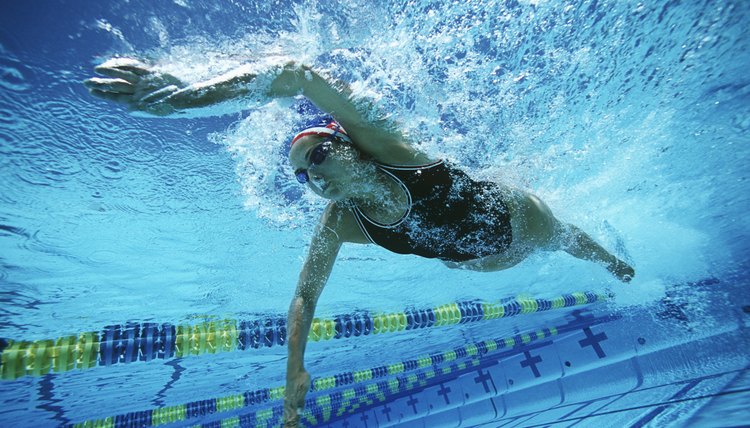Swimming Pool Strength Workouts

While pool strength workouts might not be for everyone, there are specific benefits of performing resistance training in a pool, according to Certified Strength and Conditioning Specialist Michelle Roots on the Core-Condition website. A pool workout challenges your muscles as it takes extra work to move against the resistance of the water, though the water's buoyancy means there is less impact on your joints.
First Things First
Before you begin any strength exercises, increase your body temperature and blood flow by warming up for five to ten minutes with dynamic stretches. You’ll have a much more effective workout if your neuromuscular system is stimulated before you start to work at your regular intensity. Begin by swimming a few laps and then incorporate flutter kicks while holding onto the edge of the pool. Also do arm circles, torso twists and high-knee marching while standing in shoulder-height water. You should feel completely warm before moving onto the strength exercises, which will be more challenging.
Working the Legs
To build strength in your legs, incorporate the K-tread, wave maker and jump squats into your workout. K-tread, which you do in deeper water, involves treading while sweeping your legs forward and back in a scissor-kick motion. Alternately drive one leg forward at the hips while bringing the other leg back until it is directly underneath you. This move will work your glutes, hamstrings, hip flexors and quads.
To perform the wave maker, hold onto the edge of the pool with both hands with your arms extended and body floating on the water. Drive your legs into the water, leading with your knees, and then follow with your lower legs and feet. Lift your legs back up and then repeat, trying to create waves as large as possible.
Do jump squats in water that is about waist-height. Stand on the pool floor with your feet at about hip-width distance and then lower into a squat until your shoulders are under the water and then explode up into a maximum-height jump. As soon as you land, drop back down to go into the next rep.
Hitting the Core
For your abdominals and obliques, you can include the otter roll and situps into your session. You’ll need a beach ball for otter roll. Float on your back with your legs straight and hug the beach ball to your chest. Roll left to move your body out of the water and then continue until you do a 360-degree spin and return to a back-lying position. On the next rep, roll to your right. To perform situps, position your lower legs over the edge of the pool so that your knees are bent to 90 degrees and your torso is lying atop the water. Bend forward at the waist to move your chest toward your knees and then lower back down.
Developing Your Upper Body
Do beach ball lever and dips to develop strength in your upper body. As suggested by its name, beach ball lever requires the use of a beach ball. Float on your stomach and hold the ball with both hands and with your arms extended so that the ball is positioned under your chest in the water. Keep your torso and legs stationary and your arms straight as you raise the ball up and in front of you until it reaches the top of the water. Swing it immediately back underneath you and repeat.
To perform dips, sit on the edge of the pool with your lower legs in the water. Position your hands on the edge of the pool on either side of your hips and then place your body weight onto your hands and slide your hips forward. Bend your elbows to lower your body into the pool, continuing until your elbows are bent to about 90 degrees, and then extend them to come back up.
References
Writer Bio
Kim Nunley has been screenwriting and working as an online health and fitness writer since 2005. She’s had multiple short screenplays produced and her feature scripts have placed at the Austin Film Festival. Prior to writing full-time, she worked as a strength coach, athletic coach and college instructor. She holds a master's degree in kinesiology from California State University, Fullerton.
